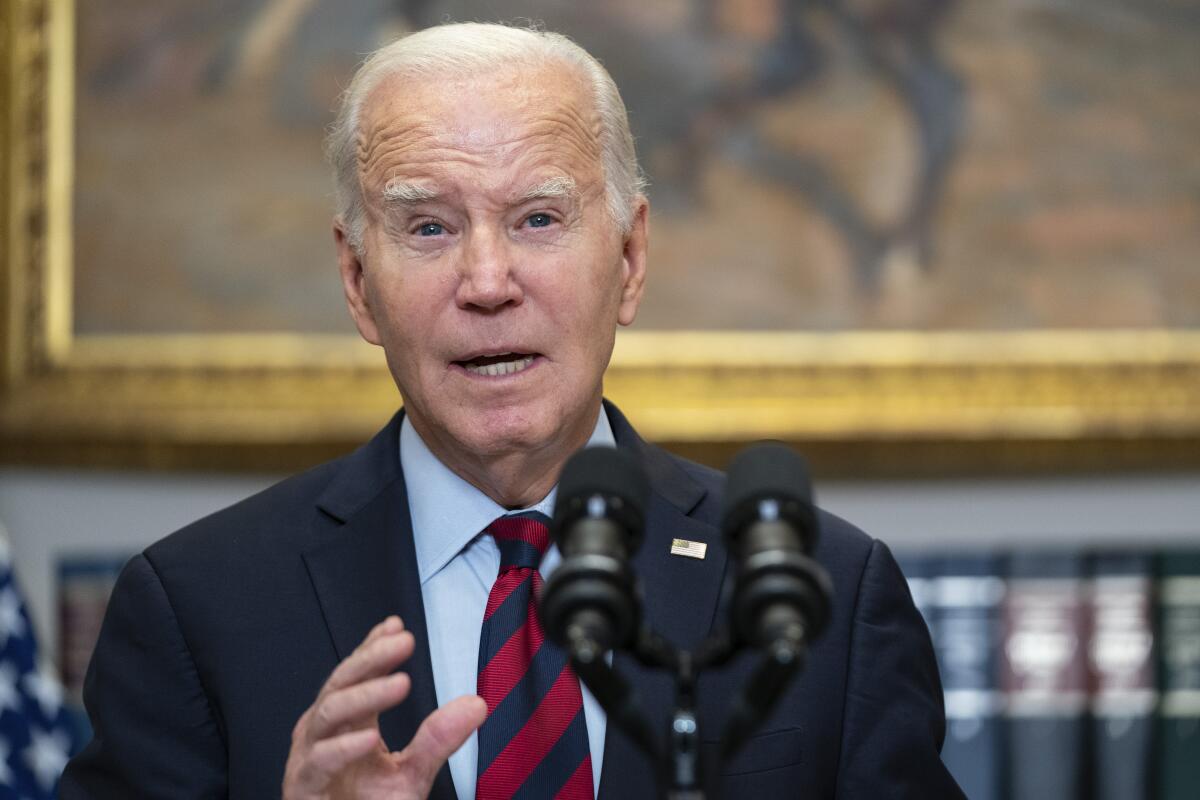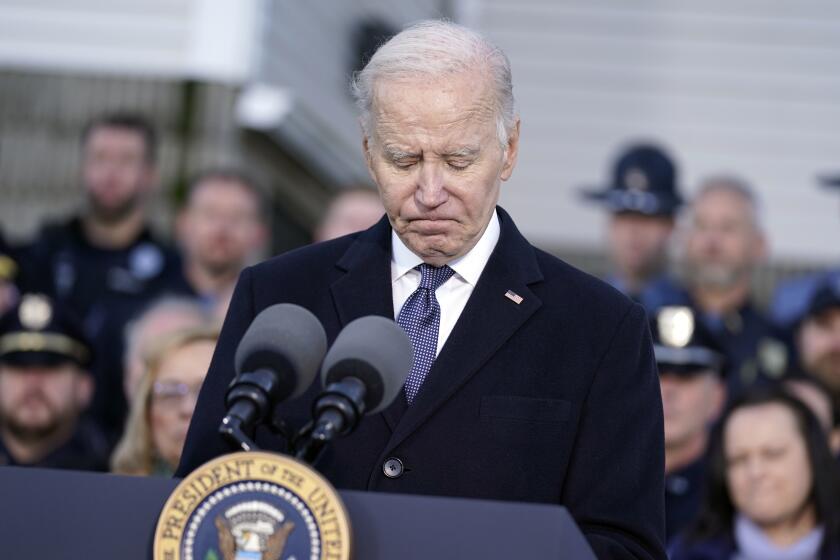Biden wants to complete his goals on civil rights, taxes and social services if reelected

- Share via
WASHINGTON — President Biden has a simple reelection pitch to voters — let him “finish the job.”
So what does that mean? What’s left for him to get done?
Unlike Donald Trump, the front-runner for the 2024 Republican presidential nomination who has been releasing videos and statements detailing his agenda, Biden hasn’t formally released his plans as part of his campaign.
But his ambitions are no secret, and his goals for child care, community college and prescription drugs have been laid out in detail during the Democrat’s first term. He also has unfulfilled promises on civil rights, such as protecting access to the ballot box, preventing police misconduct and restoring the nationwide right to abortion. Banning firearms known as assault rifles remains a priority as well.
The result is a second-term agenda that could look a lot like Biden’s first-term agenda, with some of the same political challenges. Almost none of this can get done without cooperation from Congress, and many of these goals already have been blocked or pared down because of opposition on Capitol Hill.
Biden has achieved bipartisan victories on infrastructure projects and public funding for the domestic computer chip industry. But Democrats would need to win wide majorities in both the House and the Senate to clear a path for the rest of his plans.
“We’re going to finish as much of the job as we can in the next year,” said Bruce Reed, Biden’s deputy chief of staff. “And finish the rest after that.”
A UC Berkeley-L.A. Times poll shows approval of President Biden has dropped among key voter groups. In solidly Democratic California, he still tops Donald Trump.
Biden’s campaign expressed confidence that the president’s agenda would stack up well against Republicans in next year’s election. Kevin Munoz, a spokesman, described the election as “a choice between fighting for the middle class or shilling for rich special interests” and he said, ”it’s a contrast we are more than happy to make.”
One other difference between Biden and Trump doesn’t fit neatly into policy white papers, but it’s core to their political foundation. Biden has made defending American democracy a cornerstone of his administration, while Trump tried to overturn his election loss in 2020.
The result of the 2024 campaign could reshape not only government policy but the future of the country’s bedrock institutions.
Biden’s plans are expensive and he doesn’t want to increase the deficit, so that means he’s looking to raise taxes on the wealthy.
He already has succeeded in implementing a 15% minimum tax on companies with annual income exceeding $1 billion.
Biden has proposed raising the top tax rate to 39.6%, the corporate tax rate to 28% and the stock buyback tax to 4%.
He wants a minimum tax of 25% on the wealthiest Americans, a levy that would be applied not only to income but unrealized capital gains. The idea, which Biden called the “billionaire minimum income tax,” could prove difficult to put in place, not to mention extremely hard to push through Congress, given Republican opposition to higher taxes.
Biden’s original signature plan was known as Build Back Better, a cornucopia of proposals that would have dramatically changed the role of the federal government in Americans’ lives.
It was pared down because of resistance from Sen. Joe Manchin, a West Virginia Democrat who is not seeking reelection and has been a key vote in the narrowly divided Senate. The result was the Inflation Reduction Act, which included financial incentives for clean energy and limits on prescription drug costs, but not many other programs.
Biden will want to bring back the ideas that were left on the cutting room floor. That includes making two years of community college tuition free, offering universal preschool and limiting the cost of child care to 7% of income for most families.
He also wants to resuscitate the expanded child tax credit. The American Rescue Plan, the pandemic-era relief legislation, boosted the credit to $3,000 for children over 6 and $3,600 for children younger than age 6. The expansion lapsed after a year, returning the credit to $2,000 per child, when his original package stalled.
More work is left on prescription drugs. The monthly cost of insulin was capped at $35 for Medicare recipients. Biden wants the same limit for all patients.
The White House recently announced a new office dedicated to preventing gun violence. Biden also signed legislation that’s intended to help officials keep guns out of the hands of domestic abusers and other dangerous people.
But Biden’s biggest goal, a ban on so-called assault weapons, remains out of reach because of Republican opposition. Such a ban was in place from 1994 to 2004, but it wasn’t extended after it expired. Although the proposal hasn’t been spelled out in detail, it would likely affect popular high-powered weapons such as the AR-15, which can shoot dozens of bullets at a fast pace.
Another item on the wish list is universal background checks, which increase scrutiny of sales conducted through gun shows or other unlicensed avenues.
Biden took office at a time of national upheaval over the role of racism in policing and the future of democracy. George Floyd, a Black man in Minneapolis, was murdered by a white police officer, and Trump tried to overturn Biden’s election victory, leading to the riot on Jan. 6, 2021, at the U.S. Capitol.
Biden promised to address both of these issues through landmark legislation, but he came up short of his goals.
On policing, bipartisan negotiations on Capitol Hill failed to reach a deal, particularly when it came to making it easier to sue over allegations of misconduct. So Biden instead crafted an executive order with input from activists and police. The final version changes rules for federal law enforcement, but it does little to alter how local departments do their jobs.
He similarly issued an executive order on voting rights that aims to expand registration efforts. But Democratic legislation intended to solidify access to the ballot box failed to advance when some members of the party refused to sidestep Senate filibuster rules to pass it.
Biden’s presidency was upended by the Supreme Court’s decision to overturn Roe vs. Wade, which guaranteed nationwide access to abortion. It’s proved to be a potential campaign issue for Democrats, but they have had less success in Congress. Biden said that if his party picks up more seats, he will push for legislation codifying the right to abortion.
On Biden’s first day in office, he sent Congress his proposal for overhauling the country’s immigration system. The idea went nowhere.
But the president would want to take another swing at the issue in a second term. It will prove an especially urgent topic as migrants continue crossing the U.S.-Mexico border and the country looks for the next generation of workers to achieve its economic goals.
Biden wants to allow people who are in the United States illegally to apply for legal status and eventually citizenship. He also wants a smoother and expanded visa process, particularly for foreign graduates of American universities. These steps would be paired with additional resources for border enforcement.
Biden is facing two wars on two continents, and the fallout from each conflict will shape a second term even if the fighting ends before that.
The Russian invasion of Ukraine has been going on for almost two years, and Israel and Hamas began their latest clash about a month ago. Biden wants to send military support to Ukraine and Israel, something that he describes as “vital” to U.S. national security interests.
“History has taught us when terrorists don’t pay a price for their terror, when dictators don’t pay a price for their aggression, they cause more chaos and death and more destruction,” he said in a recent Oval Office address.
His plans will require challenging congressional negotiations. Some Republicans are resisting more assistance for Ukraine after Congress has already approved $113 billion in security, economic and humanitarian resistance.
Both conflicts will likely require years of U.S. involvement. For example, Biden is looking for a new opportunity to push for a two-state solution in the Middle East, creating an independent Palestinian country alongside Israel.
Fighting global warming is one of the areas where Biden has had the most success. The Inflation Reduction Act includes nearly $375 billion for climate change, much of it going toward financial incentives for electric cars, clean energy and other initiatives. Biden is also pushing stricter regulations on vehicles and power plants.
But the U.S. is not yet on track to meet Biden’s ambitious target for reducing greenhouse gas emissions, according to independent analysts. And there’s a lot of work ahead to ensure new programs reach their potential.
One hurdle is red tape for energy projects. The White House argues that it’s too hard to build infrastructure such as transmission lines, but legislation to address the issue would likely require compromises with Republicans, who see an opportunity to grease the skids for additional fossil fuel development.
More to Read
Sign up for Essential California
The most important California stories and recommendations in your inbox every morning.
You may occasionally receive promotional content from the Los Angeles Times.











